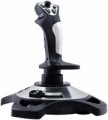Cable length
The length of the cable provided in the design or delivery set of the wired or combined controller (see "Connection").
In general, the meaning of this parameter is obvious: a longer cable gives more freedom of movement, but can create inconvenience at short distances. In fact, the length of the wire is important mainly in cases where a wired connection is used to play on a large screen: for comfortable viewing, it is desirable to be at a fairly large distance from such a screen. However, even in this case, a relatively short cable can be compensated for by the length of the wires going from the console (or other gaming device) to the screen, or even by connecting the set-top box to the screen wirelessly (many modern models have this capability). If the controller is used for a computer, this parameter can be ignored: the system unit or laptop is usually located in close proximity to the user, and even a fairly short wire is enough to connect.
Number of buttons
The total number of buttons provided in the design of the manipulator.
The more buttons — the more additional features you can "tie" to the manipulator, the lower the likelihood that during the game you will have to turn to other controls (for example, a PC keyboard). However, many game consoles (see "Platform Compatibility") provide a certain minimum number of buttons for a compatible gamepad — a smaller number simply would not allow full use of all the functions of the console. For example, the original PlayStation 4 controller has 11 buttons.
Note that the D-Pad (see below) is not included in this calculation: it is considered a specific control, although it is based on buttons.
Material
The main material(s) used in the design of the manipulator.
Usually, both the body of the device and the control elements — buttons, levers, joystick handle, etc. are made from the material specified in this paragraph. steering wheel ”(see above), the type of coverage is often specified.
Here are the main materials relevant for today:
— Plastic. It is used in the vast majority of modern game controllers — from low-cost to high-end; at the same time, even in inexpensive devices, sufficiently high-quality grades of plastic can be used. In general, this material combines low cost, practicality and ease of design: plastic elements can easily be given complex shapes, as well as any shades and patterns. Of the shortcomings of this option, one can only note a certain tendency to scratches; however, this is a purely aesthetic moment, having almost no practical significance.
— Rubber cover. An additional coating commonly used on plastic devices. Rubber is soft and flexible, and less slippery than a smooth plastic surface. This provides a more comfortable and secure hold in the hands. In addition, scratches are less noticeable on such material. The reverse side of these advantages is a slight increase in the cost and dimensions of the controller (the latter, however, can be compensated by reducing the size of the plastic base).
— Soft touch. A special kind of plastic, a kind of transitional option between traditional smooth pl...astic and rubber. The surface of this material has a special texture, due to which it feels soft to the touch (hence the name), besides, it practically does not slip in the hands. However for a number of reasons, such material has not received much popularity in game controllers.
— Rubberized plastic, rubberized coating. These terms may mean different materials in different models: in some cases it is plastic with a full-fledged rubber coating, in others it is a soft-touch surface. For more on both, see above; and what exactly is at stake — it is worth specifying separately.
— Rubber. The word "rubber" in this case, it is customary to denote individual elements made of this material — primarily buttons and additional inserts. Such elements are usually combined with a body base made of plastic (see above). And rubber is used for additional convenience: fingers do not slip off such buttons as much as with plastic ones, while inserts prevent the controller itself from slipping in your hand.
— Metal. In the case of game controllers, metal is a premium material: it is durable, looks solid, but it is not cheap. And in some types of manipulators — for example, gamepads (see "Device type") — the use of this material is not justified from a practical point of view. As a result, metal is mainly used for individual high-end rudders, joysticks / helms and aircraft instruments, designed both for functionality and for realism in appearance and user experience. At the same time, even if only metal is indicated in the characteristics, the design, usually, still includes individual elements from other materials: for example, the pad on the joystick lever can be made of rubber or plastic, for additional comfort and reliability.
— Aluminium. One of the types of metal described above — with all the characteristic features. Aluminium is often perceived as an advanced and expensive material (in particular, it is widely used in aviation); therefore, sometimes in the characteristics this name is specified for advertising purposes.

